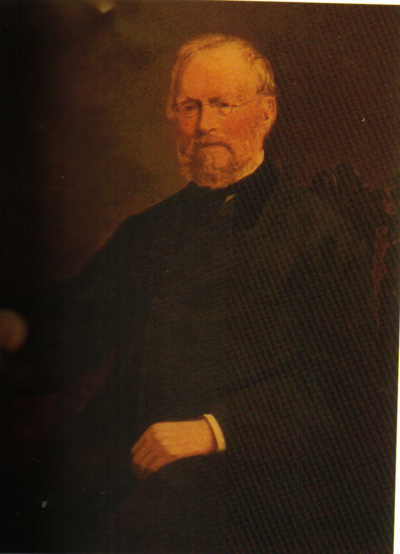Today’s An Irishman’s Diary
by Donal Musgrave
in the Irish Times

James Dwyer (1798-1889), founder of a dynasty of Cork merchant princes that flourished up to the 1980s
‘Are you one of the ____s? This question, strangely peculiar to Cork, invariably crops up if your name happens to be Dwyer, Musgrave, Crosbie, Mahony, or some other such appellation redolent of the city’s merchant class.
Whether one’s surname reeks of faded glory or smacks of current wealth and power, at a dinner party or over a pint it can give rise to a pointed query.
As Martin Dwyer recalls: “Growing up in Cork in the fifties and sixties I was always aware of a certain privilege attached to the name Dwyer. When introduced to someone new there was always that little flicker of the eyes and the question: ‘Are you related to. . ?’ ”
Mary Leland’s Dwyers of Cork is a lively, fascinating and comprehensive work, full of social, economic and historical insights, depicts the city of the merchant princes in its heyday.
The picture inside the front cover says it all. The 1913 wedding party photograph of the marriage of William Dwyer and Agnes Harding shows strong women bedecked in their finery flanked by comfortable, relaxed-looking businessmen brimming with the confidence bred of success. Underlining the economic importance of the union, there are two priests.
William was the grandson of James Dwyer, the 19th-century founder of a family dynasty that flourished up to the 1980s, while Agnes was the grand-daughter of John Francis Maguire, founder of the Cork Examiner. Although not what you would call a “made marriage”, theirs was a marriage “within a class”, writes Leland – “almost within a caste, an elite born from what Oscar Wilde called the purple of commerce”.
Intriguingly, given Ireland’s growing obsession with “roots” and family trees, it was an outbreak of curiosity among the present-day members of the family about their antecedents, and their subsequent efforts to identify the various Dwyers and Maguires in the photograph, that prompted this publication.
With deft brush-strokes and a journalist’s eye for detail, Mary Leland weaves a colourful tapestry of Cork’s social, family, business, economic and political entanglements.
From the outset, James Dwyer symbolised the emergence of powerful middle-class Catholic families in Cork and the gradual decline of the Protestant upper classes. Pre-eminent among the new breed of innovators and manufacturers, he was in fact a blow-in from Tipperary. In his day, however, he was to become one of the most prominent and influential of Cork’s citizens.
An entrepreneur long before the word was in vogue, he founded a family business that was to last for over 160 years. Between the 1820s and the 1980s, from their base in Washington Street, the Dwyers built up an empire that employed thousands of people in a manufacturing conglomerate that included such names as Sunbeam Wolsey, Seafield Gentex, Perdix Shirts and Knitwear, Templemichael Mills, the Lee Boot Factory and Hanover Shoes.
Reflecting the business flair of the man who went on to establish a dynasty, he “took leave to inform his customers on August 25th 1827, of ‘a large addition to his former stock on the most advantageous terms’.”
Newspaper advertisements described an Aladdin’s Cave of “pearl, bone and horn buttons, studs, Raven and Japan sewing silks, coloured silk galloons, tapes, bindings, hooks and eyes, hat bindings, buckles and bands, cottons and silks and worsted suspenders, rich Parisian fringes, rich bell ribbons and ropes, coach-makers’ trimmings, cottons and silks, garters, wig powders and wafers, gilt, lacquered and black cloak clasps”.
Towards the end of the 19th century James Dwyer attributed a doubling of sales largely to the efficiency of employees. In recognition of their efforts, “we have set aside for distribution amongst them as bonus a substantial sum out of the profits of the past year”. Incidentally, he hoped the move would have the effect of “stimulating increased exertion”.
As Mary Leland observes, “a bonus must have meant a lot to the workers at a time when junior clerks might earn as little as 12 shillings a week and the average annual salary of shop assistants came to £20. Women on the factory floor for a 56-hour week in 1900 were lucky to be paid as much as five shillings.
Among those earning a general salary of £10 a month was Terence McSwiney, a future Lord Mayor of Cork, who was to die on hunger strike in Brixton Prison in 1920 – a death which drew the attention of the world.
Through Leland’s in-depth research and the clarity of her writing, we get a fascinating insight into the profound influence of the “Dwyers of Cork” on the life and times of the city over a period spanning more than a century-and-a-half.
By the 1980s, however, the sun was setting on a business empire which once provided the Dwyers with all they wanted – houses, cars, servants, grooms, stables, school fees, holidays, clothing furniture and fittings.
Thanks to the business acumen of Ted Dwyer, publisher of the family history, you can buy this richly illustrated, 188-page coffee-table book for €30. It’s an ideal present for anyone interested in the history of Ireland’s “real” capital city.

Comments
Eileen DWyer
on December 30, 2008He’s the spit of you Dad!
The comments are closed.